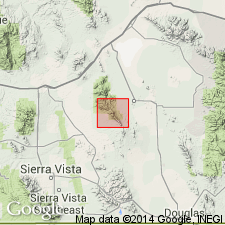
- Usage in publication:
-
- Stronghold granite
- Modifications:
-
- Original reference
- Dominant lithology:
-
- Granite
- AAPG geologic province:
-
- Pedregosa basin
Summary:
Pg. 610-611. Stronghold granite. In most places, is white where fresh and light-yellow where weathered, medium- to coarse-grained texture, and may be described as porphyritic, although porphyritic character not everywhere readily apparent in hand specimens. Intrusive into Mesozoic rocks and considered to have been implaced during Laramide Revolution.
Makes up Cochise Stronghold mass, a natural fortress within northern part of Dragoon Mountains, in R. 23 and 24 E., T. 16 and 17 S., Cochise Co., southeastern AZ, and extends southward as narrow bands in the Dragoon Mountains.
Source: GNU records (USGS DDS-6; Denver GNULEX).
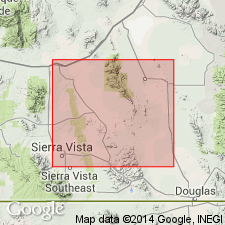
- Usage in publication:
-
- Stronghold granite*
- Modifications:
-
- Revised
- Dominant lithology:
-
- Granite
- AAPG geologic province:
-
- Pedregosa basin
Summary:
Pg. 9 (table), 106-108, pl. 5. Stronghold granite. Three major facies recognized: (1) main facies, rather coarse-grained granite ranging from light-gray to light-pink and weathers buff; (2) border facies, porphyritic, though not conspicuously so; and (3) apilitic facies, differs only slightly from border facies though it seems to contain even less biotite. Youngest major intrusion in region. Cuts Dragoon thrust sheets in many places, and at one place or another it is in intrusive contact with representatives of all rocks from Pinal schist to Bisbee formation. Younger than Cochise Peak quartz monzonite. Mapped as Eocene(?) to lower Pliocene(?).
Source: US geologic names lexicon (USGS Bull. 1200, p. 3754-3755).
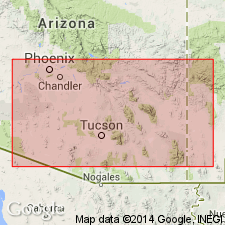
- Usage in publication:
-
- Stronghold Granite
- Modifications:
-
- Age modified
- Geochronologic dating
- AAPG geologic province:
-
- Pedregosa basin
Summary:
Stronghold Granite. Age is Miocene (22 +/-3 Ma).
Source: GNU records (USGS DDS-6; Denver GNULEX).

- Usage in publication:
-
- Stronghold Granite*
- Modifications:
-
- Geochronologic dating
- AAPG geologic province:
-
- Pedregosa basin
Summary:
Samples collected from Stronghold Granite in the Dragoon Mountains, AZ, Lat. 31 deg. 56 min. N., Long. 109 deg. 59 min. 30 sec. W. Age is Miocene. K-Ar ages on biotite 26.0 +/-2 Ma and .
Source: Modified from GNU records (USGS DDS-6; Denver GNULEX).

- Usage in publication:
-
- Stronghold Granite*
- Modifications:
-
- Age modified
- AAPG geologic province:
-
- Pedregosa basin
Summary:
Stronghold Granite. Radiometric age of 27 Ma (Oligocene). Previously considered Oligocene to Miocene.
Source: Modified from GNU records (USGS DDS-6; Denver GNULEX).
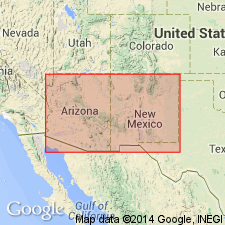
- Usage in publication:
-
- Stronghold Granite*
- Modifications:
-
- Age modified
- Geochronologic dating
- AAPG geologic province:
-
- Pedregosa basin
Summary:
Samples collected from Stronghold Granite in the Dragoon Mountains and vicinity, Cochise Co., AZ. Age changed from Oligocene to Miocene; [age probably should be Oligocene or Miocene]. Age corrected from 22 +/-3 Ma to 27 +/-2 Ma.
Source: Modified from GNU records (USGS DDS-6; Denver GNULEX).
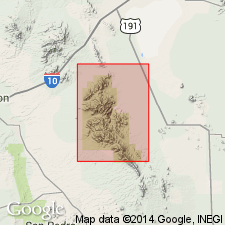
- Usage in publication:
-
- Stronghold Granite*
- Modifications:
-
- Mapped 1:24k
- Geochronologic dating
- Dominant lithology:
-
- Granite
- AAPG geologic province:
-
- Pedregosa basin
Summary:
Stronghold Granite (Miocene and Oligocene). Stock, approaching batholith size, mapped in T. 17 and 18 S., R. 22, 23, and 24 E., Cochise County, southeastern Arizona. Coarse-grained, very pale-orange to very light-gray, massive, alkali granite. Typically hypiodiomorphic granular and granophyric textures. Sample from east lobe yielded a fission-track age (zircon) of 28.1 +/-1.3 Ma (C.W. Naeser and M. Mayorchi, written commun., 1982). Previously published samples from west lobe and core area yielded K-Ar ages of 27 +/-2 Ma and 24.1 +/-2.0 Ma (biotite), respectively (Marvin and others, 1978, modified from Marvin and others, 1973); and 22 +/-3 Ma, probably using old constants (Damon and Bikerman, 1964). Age of stock is late Oligocene. Report includes modal analyses.
Source: Publication.
For more information, please contact Nancy Stamm, Geologic Names Committee Secretary.
Asterisk (*) indicates published by U.S. Geological Survey authors.
"No current usage" (†) implies that a name has been abandoned or has fallen into disuse. Former usage and, if known, replacement name given in parentheses ( ).
Slash (/) indicates name conflicts with nomenclatural guidelines (CSN, 1933; ACSN, 1961, 1970; NACSN, 1983, 2005, 2021). May be explained within brackets ([ ]).

